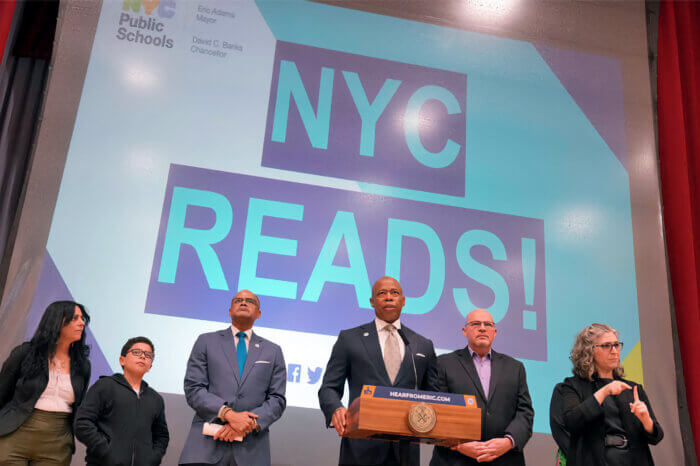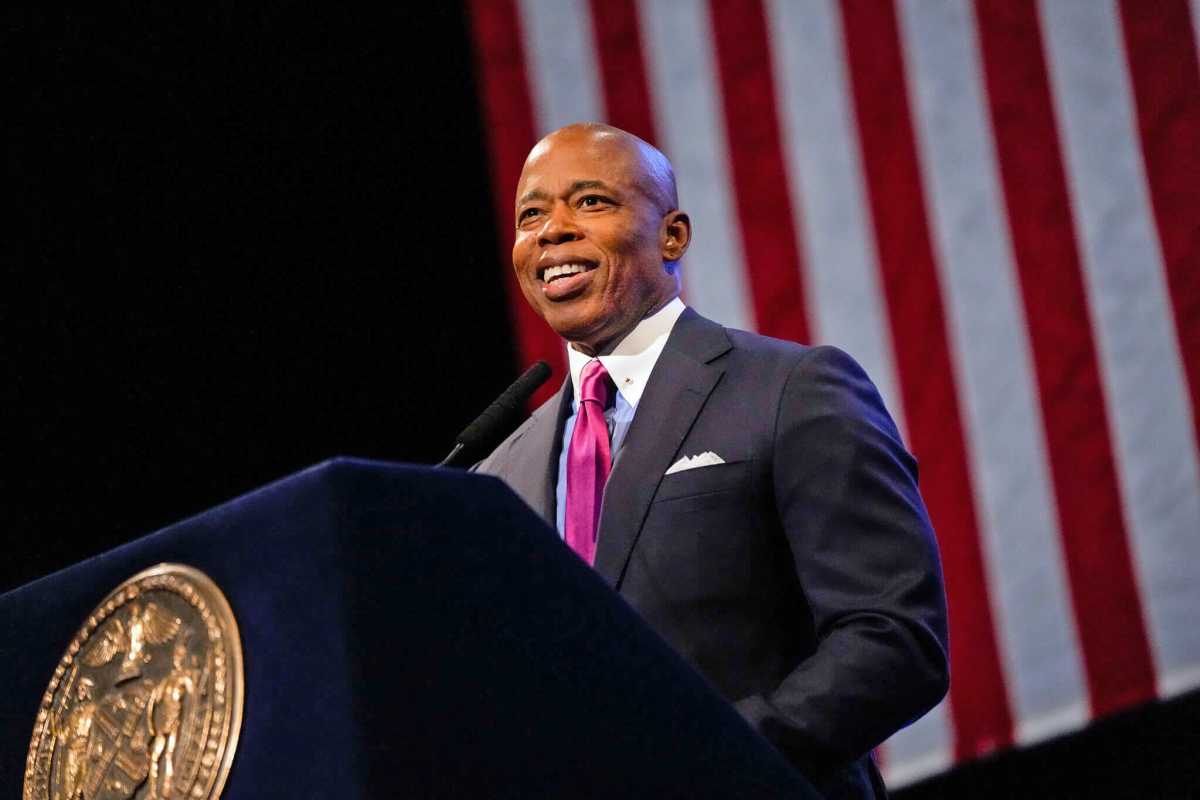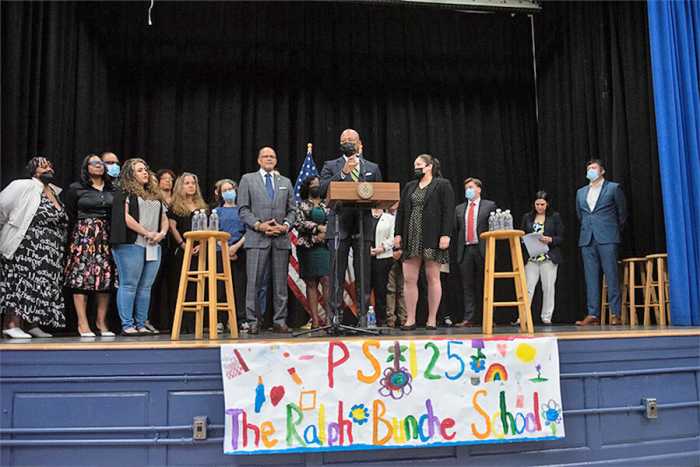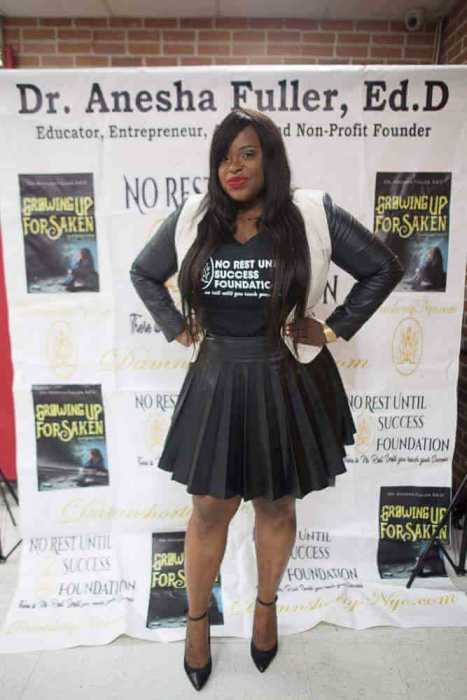New York City Mayor Eric Adams and New York City Department of Education (DOE) Chancellor David C. Banks on Tuesday launched “New York City Reads,” a major citywide campaign to declare literacy and reading instruction as the core focus and overriding priority of New York City’s public schools.
Adams said this multi-pronged, long-range campaign renews the commitment of public schools to the primary responsibility of ensuring the city’s students become confident readers and are able to learn basic algebra.
With half of New York City students not proficient at reading, and more than two-thirds nationally, Mayor Adams and Chancellor Banks declared that now is the time for the city and nation to act.
“The most basic thing we can do at our schools is ensure that all our students learn how to read and have the resources to thrive, but with more than half of our city’s public-school students reading below grade level, now is the time to act — and that is exactly what we are doing today,” said Mayor Adams. “‘New York City Reads’ is a historic curriculum shift in the largest school district in the nation that will bring proven science-of-reading and phonics-based methods to all of our public-school students, starting with our early childhood programs and our elementary schools.
“We owe it to our young people, and we owe it to our educators who have been working hard to teach without access to the right tools,” he added. “Through this campaign, New York City is finally setting up our students and teachers for success.”
“Teaching children to be confident readers is job number-one,” said DOE Chancellor Banks. “Literacy is the foundation for all learning, and it is absolutely essential to a clear path to our students’ bold futures.
“By making an investment of resources in our children’s reading development, we are investing in their future, our city, and our nation,” he added. “It is our collective responsibility to ensure every child has the tools, resources, and support needed to unlock their full potential and open every door of opportunity.”
Adams said the New York City Reads campaign focuses classroom instruction on “proven, research-based curricula, supported by intensive coaching and professional learning for educators aligned with those specific curricula, in order to ensure all public-school students, in every neighborhood, regardless of their background or identity, is experiencing rigorous, relevant, engaging reading instruction that works.”
Implemented over two years, the mayor said this initiative will streamline and enhance curricular resources in early childhood and elementary classrooms, as well as in high school algebra courses.
Additionally, he said it will provide about $35 million next year for training and coaching to help teachers and leaders effectively implement the classroom materials and address their students’ needs.
In a change from past efforts, Adams said every educator responsible for teaching the curricula will receive intensive, high-quality training prior to the start of the year, “so they will be well-prepared for the start of the school year and will receive continuing coaching two to three times a month during the course of the school year.”

Bright Starts in Early Childhood Programs
Starting in the 2023-2024 school year, all New York City public school early childhood programs will adopt and implement “The Creative Curriculum” — a nationally used, research-based program. Alongside this curriculum, early childhood programs will use “Teaching Strategies GOLD,” an authentic child assessment system, and “Ages & Stages,” a developmental screener to inform the planning of rich learning experiences tailored to each child’s strengths, interests, and needs.
The mayor said program staff will receive intensive professional learning in the spring and summer in preparation for implementation in the fall, “ensuring that all children are able to enter kindergarten with the literacy and math skills needed for academic success.”
Every Elementary School, Every ELA Classroom, Every Student
Phase one of the plan will begin next school year with superintendents in 15 community school districts selecting a single research-backed curriculum for use in all elementary school ELA classrooms.
Adams said educators will receive intensive training from a curriculum-aligned professional development partner organization this spring to prepare for full implementation in the fall.
He said superintendents will choose between “Into Reading,” “Wit & Wisdom,” and “EL Education” based on engagement with principals and an analysis of current school materials.
In phase two, Adams said the remaining 17 districts will purchase new curriculum materials in the fall of 2023 and spend the year preparing for full implementation in the 2024-2025 school year.
A Strong Math Foundation for a Bold Future
Beginning in the 2023-2024 school year, the mayor said 178 high schools across seven superintendents’ districts will implement a consistent, research-based Algebra 1 curriculum.
“Mastery of Algebra early is critical for students to reach calculus by 12th grade and is linked to increased chances of earning a bachelor’s degree, particularly for low-income students,” he said. “Algebra is often considered the ‘gatekeeper’ to higher-level math and science courses that can lead to science, technology, engineering, and math (STEM) careers.
“All high schools will receive curriculum-aligned professional learning and coaching from external partners with a strong track record of success,” Adams added. “After reviewing all core curriculum options, superintendents chose Illustrative Mathematics.”
Further Expansion Coming
The mayor said early literacy is the “most critical skill” students must develop to be successful in school.
He said the first two phases of “New York City Reads” campaign will focus heavily on ensuring that the city’s early childhood programs and elementary schools are providing that foundational education.
“Beyond Algebra 1, the city recognizes that more core subject areas will benefit from consistent, research-based materials,” Adams said. “DOE will assess and work with stakeholders to identify initial lessons learned from this rollout and identify additional subject areas and grade bands for expansion in the coming years.”
Putting Students with Disabilities and Multilingual Learners at the Center
“Special populations were the most impacted by instructional loss during the COVID-19 pandemic and are at the center of New York City public schools’ curriculum planning,” the mayor said. “For students with disabilities, the curriculum will be delivered through intensified, tiered supports and specially designed materials tailored to their needs.”
He said the Special Education Office will offer curricular support in key areas such as pacing and prioritizing, building knowledge through various experiences and modalities, ensuring access to educational technologies, providing writing support, and identifying supplementary texts for practice and success.
For multilingual learners, Adams said schools will facilitate the implementation of the core curriculum using DOE’s existing resource collection, which demonstrates how to provide instructional support for grade-level content (e.g., ELA, math) in a culturally- and linguistically-responsive manner.
He said New York City public schools will deliver professional learning by leveraging research-based elements that publishers have already incorporated into their programs for multilingual learners, through central, district, school-level educators, and partner organizations offering onsite coaching.
Enhancing with New York City-Made Culturally Responsive Materials
“New York City houses diverse cultures, and the learning materials presented to its students should mirror the diversity in their communities,” Adams said.
While other states choose to restrict academic freedom, he said DOE believes that its students must “explore the full scope of history and human experience to become active citizens in the United States and in the world.”
In addition to standardized curriculum, Adams said the city’s public schools will offer New York City-created, ELA-specific resources under the “Hidden Voices” initiative, a joint effort between DOE, academic institutions, scholars, and community leaders to spotlight the stories of countless individuals often overlooked in history books.
These stories feature people who championed their beliefs and defied expectations. So far, DOE has already released Hidden Voices curricular resources covering Asian Americans, Pacific Islanders, and the LGBTQ+ community, with more in development, such as a comprehensive Black studies curriculum.
Adams said professional development connected to curriculum adoption will help educators learn how to adapt foundational material to include a broader range of authors, stories and subjects.


























